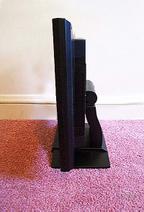|
|
 |
|
DTI3D - A journey through three dimensions Added on: Tue Sep 25 2001 |
| Page: 1 2 3 4 5 6 7 8 9 |
An LCD. A glorious black LCD just waiting to be connected to the machine. Inside the box was also some instructions explaining how to use the display, serial and HD15 cables.
 
Before we get to why a monitor has a serial cable, lets take a look at the display. The unit DTI sent me is a black 15 inch viewable LCD with a 1024x768 resolution available at 60 hertz at 16 bit color. (Like most LCD's this model can't display 32 bit colors, Also remember that Hertz for LCD's is not an issue, because there is no flicker associated with the electron gun refreshing the pixels).
It's very thin and incredibly light, so much in fact, it can fit directly in front of my Sony monitor and still leave room for the keyboard on my desk.
Setting up the monitor was easy. I just set my desktop resolution to 1024x768x60 hertz, disconnected the monitor, and plugged in the LCD. The first thing I noticed of course was how sharp the display was. LCD's really shine in the sharpness and brightness of their displays. I'm pretty sure now that the Sony monitor is beginning to die, as its definitely fuzzy when compared to the quality displayed by DTI3D's LCD.

Looking at the display itself, you'll notice on the front there is a wide variety of buttons to choose from. Various menu functions, power, and a circular led. (More on that later). Pressing the menu followed by the +/- keys allows you to manipulate contrast, colors, and 3D/2D modes. This is incredibly useful because the display has the ability to put any 3d application into a type of stereo mode making the 2D actually come out of the monitor and bonk you in the head.
You might be thinking to yourself, a 3D LCD? What type of crack is Greg smoking? Obviously it must be some good stuff, so I should go and email him for the supplier. Well before you do, let me explain. DTI uses a technology know as parallax illumination to create a stereographic 3D image to extend out of the monitor upwards of 6-8 inches*.
(*=Using patented Greg Hess measuring technology.)
|
 |
|
|




